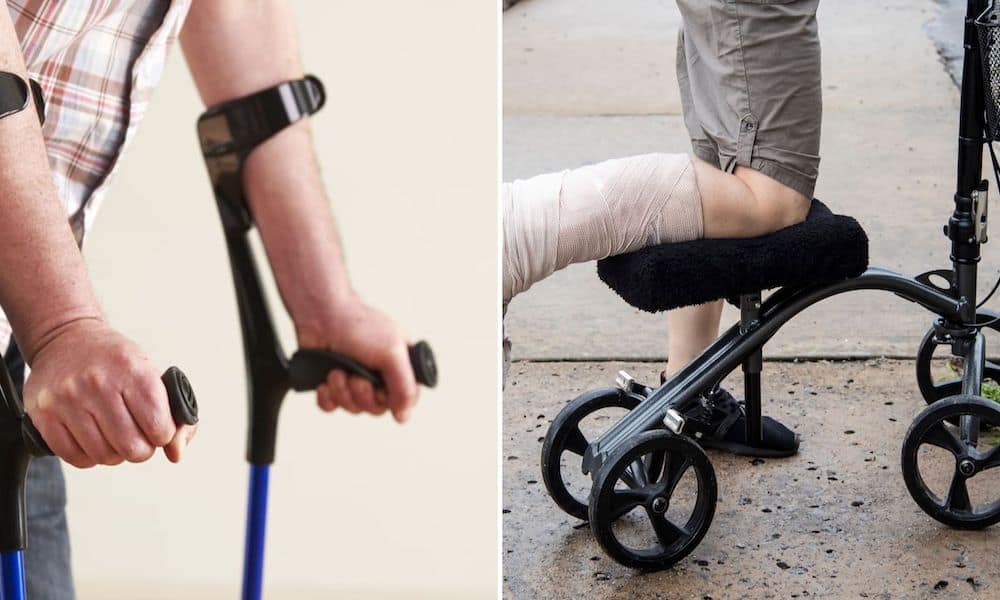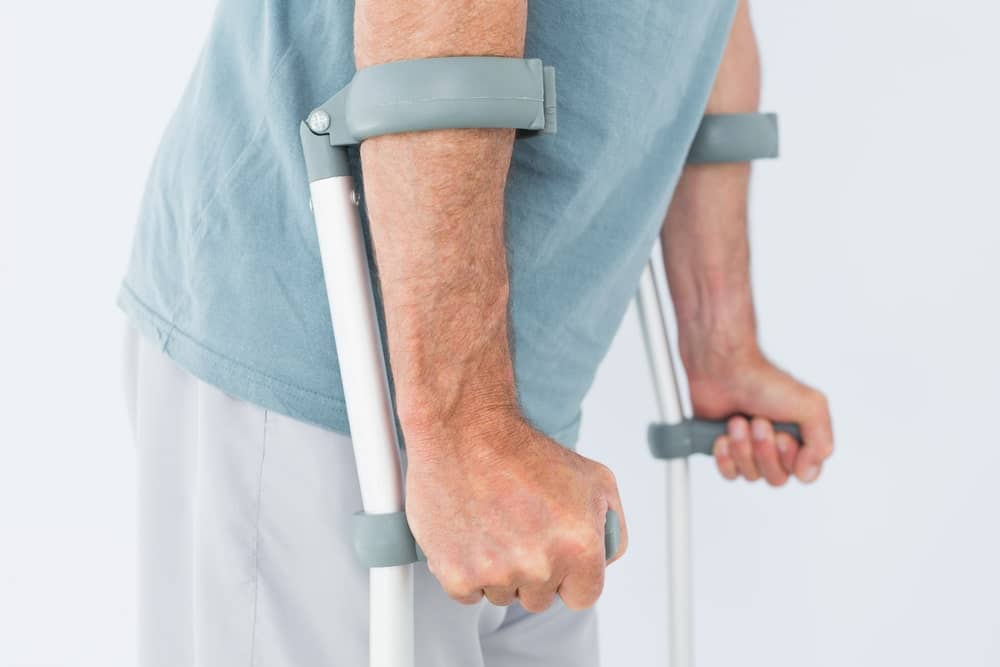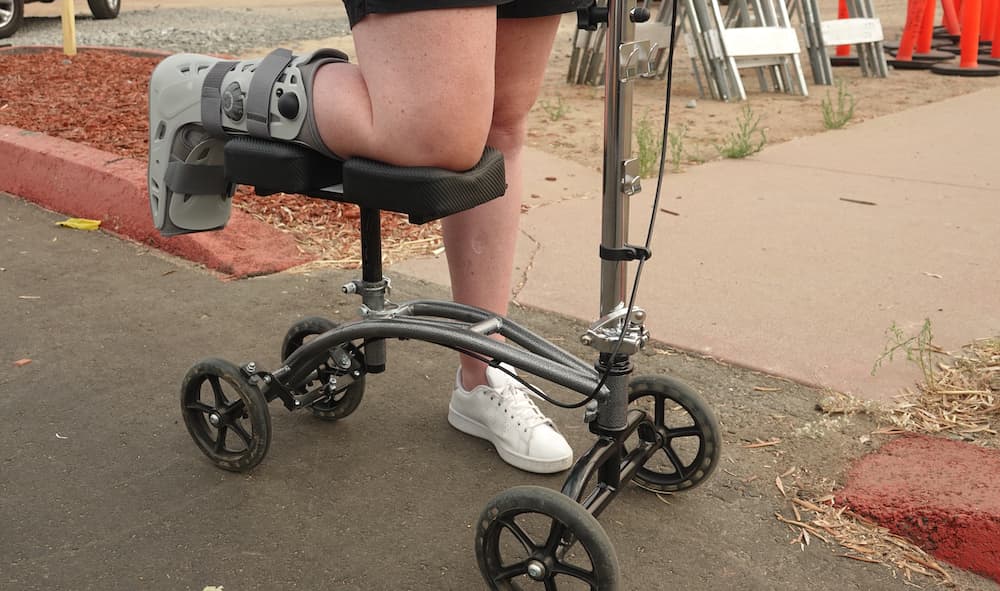Using a mobility aid that suits you and your needs is critical, as it’ll offer you more independence, reduce your pain when walking, and increase your confidence and safety. We’ve made a detailed comparison between knee scooters vs crutches, to help you decide which one is a better option for you and your needs.

Here we’ll discuss:
- What are crutches and knee scooters?
- Pros and cons of crutches.
- Pros and cons of knee scooter.
- Four key differences between crutches and a knee scooter.
What Are Crutches and Knee Scooters?
If you aren’t familiar with one or both mobility aids, here is a quick description of both.
Crutches

Crutches are a mobility aid that’s been around since the time of Ancient Egyptians, and their structure and purpose hasn’t changed that much since then.
Of course, some modifications and improvements have been made to make them more comfortable and adjustable to a user’s height and needs, but their general function and use haven’t changed for thousands of years.
Crutches transfer weight from the legs to your upper body and are used by people who can’t support their body weight with their legs, either because of a short-term injury or a lifelong mobility disorder.
Pros
- Price: Crutches are one of the most affordable options of mobility aids on the market. Check to see how much crutches cost exactly.
- Small and lightweight: Crutches are compact, making it easier to navigate narrow hallways, stairs, and small spaces, plus they’re much easier to transport, especially if you don’t have a vehicle with a lot of space.
- Easy to use: They’re easy to use and you can move fast when you are familiar with the steps.
- Provide good support: It’ll take some time to get the handle of crutches, but once you get used to them, they’ll offer you good support and balance and make it easy to navigate any type of surface and space.
Cons
- Require upper body strength: In order to use crutches, you’ll need to use quite a bit of your upper body strength, which can be difficult if you need to move around a lot.
- Pain: Since you’re putting a lot of pressure on your arms, especially when walking long distances, they can cause pain in your hands, arms, and shoulders.
- Stability: Crutches are not as stable as knee scooters, especially when walking on slippery surfaces or carrying something with you in your hands.
Knee Scooters

Knee scooters, also commonly referred to as knee walkers, are mobility aid invented in modern times as an alternative for crutches and walkers.
Over the years, it has taken many different forms; they can come as three, or four-wheeled devices, small or large, and their main objective is to be a more comfortable, safe, and easy to maneuver mobility aid. (See our post about best knee scooters)
The reason behind the name “knee scooter” is that it resembles a scooter, which utilizes an elevated and padded platform to rest your knee on and support your injured leg continuously.
Pros
- Stability: Knee scooters are lower to the floor, which makes them much more stable than crutches.
- Comfortable: The leg rest is cushioned for your comfort, plus they have extra space in case your leg is in a cast.
- No upper body strength required: Knee scooters are very easy to use and don’t require any upper body strength.
- Faster: Once you’ll get the hang of it, you can drive around pretty fast. Plus, there’s less chance of slipping on wet or slick surfaces.
Cons
- Can’t go up or down stairs: Unfortunately, you can’t use the stairs when you’re on a knee scooter.
- Price: They’re quite a bit more expensive and not as affordable as crutches.
- Not suitable for smaller spaces: The wide front wheel base makes it hard to through some narrow hallways, doors, and smaller spaces. You’ll also not be able to transport it around with you if you have a smaller vehicle as most of knee scooters are not foldable.
Knee Scooter vs Crutches: 5 Key Differences
Here are the four main differences to consider before deciding between crutches or a knee scooter.
Comfort
When it comes to overall comfort and convenience, plus ease of use, the knee scooter definitely wins by far. Knee scooters don’t require any upper body strength to get around and are much easier to navigate than crutches.
When using a knee scooter for a longer period of time, you don’t need to worry about pain. This isn’t the case with crutches—when they’re used for walking long distances, you’ll usually experience some pain in your arms, hands, or shoulders.
Overall, knee scooters are a great option for someone who has a long-term leg injury, co-occurring mobility issues, or any other more severe physical limitations and is seeking to get a mobility aid that’ll offer more comfort. Seniors like to choose them because of their muscle weakness.
Weather Resistance
Crutches can be quite difficult to use on wet surfaces and ice, so if you live in a place where it rains a lot, or roads tend to be covered with ice in the wintertime, then this isn’t the best option for you.
Knee scooters are much more weather-resistant and can be used in most climates and water conditions. They’re a much safer option and will reduce the risk of falls and slips and prevent you from injuring yourself even more.
Mobility
When it comes to overall mobility, crutches are definitely the best option here. Since you can’t really use a knee scooter indoors, where there isn’t a lot of space, or go through narrow hallways and doors, crutches will make it easy for you to move around anywhere.
You also can’t use the stairs with a knee scooter, so if you’re going somewhere where you’ll have to use a lot of stairs, you’ll be stuck and need some help with getting your knee scooter up and down.
Everyday Use
If you have a long-term injury or disability, then it’s best to invest in a knee scooter since it’ll provide you with more comfort. But you also need to consider your everyday life and what you do on a daily basis.
Do you have a small apartment where a knee scooter won’t fit in? Do you use a lot of stairs to come up to your room? Will the knee scooter make it easier for you to bring groceries from the shop to your home?
If you’re someone who needs more mobility, then definitely opt for crutches. But if mobility isn’t such a problem for you, then a knee scooter is a better option.
It also depends on how much you move around. If you’re mostly staying at home, then using crutches won’t cause you any problems such as tiredness and pain, but if you’re always on the move, then getting a knee scooter isn’t a bad idea.
Price
Generally, knee scooters are more expensive than crutches. An average knee scooter will cost about $200, however, a pair of crutches will only cost around $50. If you are on a budget but still want to have a knee scooter, you could consider getting a second-hand one.
Final Thoughts on Knee Scooter vs Crutches
Considering all the above-mentioned pros and cons and key differences between the two mobility aids, you probably have an idea which one is the better option for you.
We would recommend you consider the type of injury or disability you have. Is it long or short term? Are you even able to use a knee scooter?
Another thing to consider is your upper body strength, as people who don’t have much might find using crutches extremely difficult and tiring. Don’t forget to take mobility into account since a knee scooter won’t get you through narrow hallways and doors, plus you can’t use the stairs with it.
In the end, it all depends on you and your needs and abilities to use either one of them. Another good option, especially if you have a lifelong physical disability, is to get both—a knee scooter for longer distances or to carry around your groceries and crutches when you need more mobility, navigating narrow spaces and stairs.



